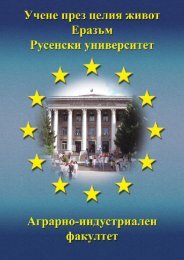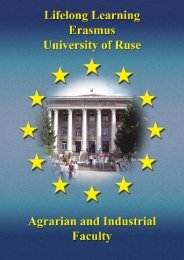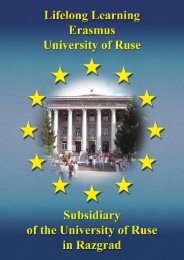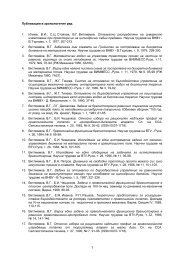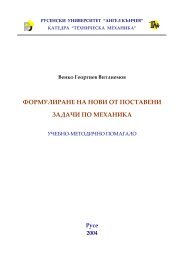Erasmus ECTS Information Package
Erasmus ECTS Information Package
Erasmus ECTS Information Package
You also want an ePaper? Increase the reach of your titles
YUMPU automatically turns print PDFs into web optimized ePapers that Google loves.
<strong>Erasmus</strong> <strong>ECTS</strong> <strong>Information</strong> <strong>Package</strong><br />
Faculty of EEEA<br />
3107 Analog Devices<br />
<strong>ECTS</strong> credits: 5<br />
Weekly classes: 2lec+0sem+0labs+2ps+2cw<br />
Form of assessment: continuous<br />
Type of exam: written<br />
Department involved:<br />
Department of Electronics,<br />
Faculty of Electrical Engineering, Electronics and Automation<br />
Lecturers:<br />
Assoc. Prof. Ivan Borisov Evstatiev, MEng, PhD, Department of Electronics, tel.: 888 772,<br />
Е-mail: ievstatiev@ecs.uni-ruse.bg<br />
Assoc. Prof. Anelia Vladimirova Manukova, MEng, PhD, Department of Electronics, tel.: 888 375, 888 682,<br />
Е-mail: amanukova@ecs.uni-ruse.bg<br />
Abstract:<br />
The Analog Devices course is compulsory and it gives the students the necessary minimum of knowledge in<br />
analog devices. It discusses the factors and methods for the realization of the most widely used low-level and<br />
power amplifiers and generator stages in a discrete and integral input, methods for dc and ac analysis of the<br />
discussed circuits, as well as instructions for their design.<br />
Course content:<br />
General information about amplifying engineering; main characteristics and operation modes. Back-coupling in<br />
amplifiers; influence of negative back-coupling on the main values of the amplifiers. Resistance of amplifiers.<br />
Aperiodic amplifiers of small signals with a common emitter, common base and common collector by middle, low<br />
and high frequencies. Cascade circuits. Aperiodic amplifiers of power. Main elements from analog devices of the<br />
analog integrated circuits. Differential amplifiers. Direct current amplifiers. Operational amplifiers - general<br />
characteristics and main circuits. The subject includes coursework.<br />
Teaching and assessment:<br />
2 hours of lectures following an alternating scheme. 2 hours of exercises carried out in two stages: analysis,<br />
design and measurement of the discussed device and/or computer analysis.<br />
Course assignment is involved. Continuous assessment during the exercises is done by oral discussions,<br />
checking of the homework and presentations of the course projects.<br />
Method of assessment: two written exams (7th and 14th week) - 80 %; course project - 20 %.<br />
3108 Radiowaves, Antenna - Feeder and Microwave Engineering<br />
<strong>ECTS</strong> credits: 7<br />
Weekly classes: 3lec+1sem+0labs+2ps+0,5p<br />
Assessment: exam<br />
Type of exam: written<br />
Department involved:<br />
Department of Telecommunications<br />
Faculty of Electrical Engineering, Electronics and Automation<br />
Lecturers:<br />
Assoc. Prof. Krassimir Petrov Manev, MEng, PhD, Dept. of Telecommunications, tel.: 888 780,<br />
E-mail: kmanev@ecs.uni-ruse.bg<br />
Abstract:<br />
Students acquire theoretical knowledge and practical skills regarding electromagnetic field bases, principles of<br />
generation and propagation of electromagnetic waves, specific element basis, constructive structure and<br />
organization of super-high-frequency (SHF) communication systems.<br />
Course content:<br />
Electromagnetic waves. Electromagnetic wave propagation in different material environments. Antenna devices.<br />
Coaxial lines. Feeder lines. Micro-wave devices. Passive SHF elements. Valve SHF devices. Semiconductor SHF<br />
devices. SHF communication systems. Safety regulations for working with microwave devices.<br />
Teaching and assessment:<br />
Lectures include 4 hours per week for the students in the 2 nd year of the Telecommunication Systems degree<br />
course. 2-hour practical exercises are conducted every week. Students have to be theoretically prepared for them<br />
and to produce a report for each exercise. Continuous assessment is made during the laboratory exercises by<br />
assigning particular tasks and verifying their accomplishment, accepting the practical exercise reports. Students<br />
are consistently consulted about the lecture material. Student duties outside lecture and exercise halls include<br />
studying from lecture notes, preparing for the practical exercises and making reports. The active form of training<br />
envisages a controlled self-dependent work (course paper) based on an individual task. The work involves<br />
computer modeling of a communication antenna choosing a corresponding feeder line.<br />
192



